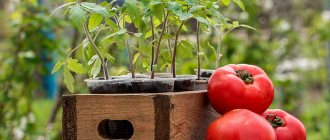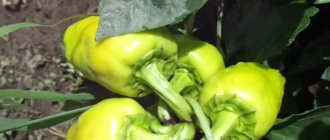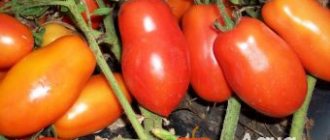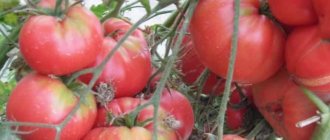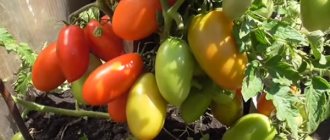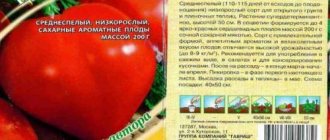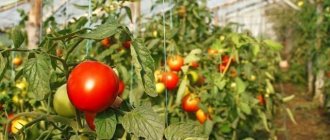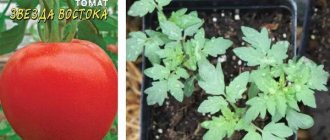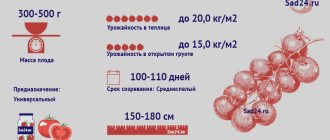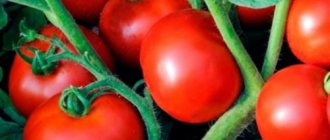The nuances of growing in open ground and in a greenhouse
The culture is recommended for cultivation in protected and unprotected soil. But in those regions that have a short summer season, the seedlings are kept under film for the first two weeks. The shelter is removed gradually, but the covering material is not removed in case of unexpected cold weather.
The Wild Rose tomato is able to grow and develop in highly saline soil
When planting in protected soil or open beds, do not thicken the bushes. The distance between seedlings should be such that each bush can receive the required amount of nutrients. Otherwise, a tall crop will not be able to fully grow and develop.
It is necessary to constantly tear off the lower leaves, otherwise they will rot from the moisture in the beds. In addition, removing the lower leaves promotes better ventilation of the plants.
Greenhouses are regularly ventilated to eliminate the causes of many diseases. The influx of fresh air has a beneficial effect on the growth of bushes and destroys pathogenic flora.
About other varieties of tomatoes:
Growing tomatoes
Such tomatoes grow well both in open ground and under film. The main thing is simple compliance with basic rules.
How to prepare seeds?
Before planting, seeds can be disinfected in the usual way using a weak solution of potassium permanganate.
Sowing seed material
Seeds are planted 6 weeks before the last predicted frost. 14 days after this, they are transplanted into wider containers so that the root system develops better.
Rules for planting seedlings
When choosing a place for replanting, be sure to select an area so that sunlight falls on it for 8 hours.
An important condition for transferring seedlings will be heating the soil. To do this, you need to cover it with black film for 7-10 days. Then make holes in it when the time comes for transplantation.
The bottom of the hole should be strewn with organic, phosphorus and potassium fertilizers, which promote the development of the root system. When placing the plant, make sure that the upper leaves are above the surface.
The bushes are planted at a great distance from each other.
Bush care
In addition to standard watering and fertilizing, this variety must be planted - new shoots are formed from 4-5 inflorescences. The first two lower stepsons will be considered the strongest.
Bushes of the Morozko variety do not need to be tied up, which slightly improves their care.
Diseases and pests
And for the prevention and control of pests, they take preventive measures using special preparations.
Features of the region
The south of Russia is a huge territory, including territories and regions with different types of climate. Temperate continental, mountainous, subtropical - variations alternate with each other, with sudden changes in weather typical. Summers are long and hot, winters are humid, with frequent thaws and slight cold. The average temperature in winter, for example, according to indicators in the Krasnodar Territory, is about +7ºC, although it can be higher.
Tomatoes are grown everywhere, sowing seeds directly into open ground. Due to the specific climate, it is necessary to select varieties that are resistant to drought and high temperatures.
In areas with low rainfall, it is important to provide irrigation systems. Drip equipment is mainly used, which is economical and has the ability to deliver moisture only to the roots of plants.
Gardeners often grow tomatoes on ridges to retain moisture in the soil and avoid overheating of the plant's root system. Minimal tillage and no-moldboard plowing are practiced.
Super early Dutch tomatoes The climate in Holland is harsh. In July, the average daily temperature does not exceed 17 °C. Dutch breeders have developed many productive tomato varieties for protected soil. They can be grown in greenhouses...
Video
You will learn how to properly form tomatoes from the following video lesson:
We also invite you to familiarize yourself with other varieties of tomatoes that have different ripening periods:
| Early ripening | Mid-late | Mid-early |
| Raspberry Viscount | Yellow banana | Pink Bush F1 |
| The Tsar Bell | Titanium | Flamingo |
| Kate | Slot F1 | Openwork |
| Valentina | Honey fireworks | Cio Cio San |
| Cranberries in sugar | Miracle of the market | Supermodel |
| Fatima | gold fish | Budenovka |
| Verlioka | De Barao black | Major F1 |
If you find an error, please select a piece of text and press Ctrl+Enter.
Tomato is one of the favorite crops of many gardeners.
To obtain a rich harvest, it is important to choose the right quality seed material.
When choosing, you need to pay attention to varieties that are suitable for growing in a particular region.
It is worth paying attention to hybrid varieties of tomatoes. They will not produce seeds the next year, but are distinguished by high early maturity and productivity, guarantee a rich harvest and high resistance to diseases
Among the hybrids, the tomato variety Morozko F1 has proven itself well. It is suitable for both industrial cultivation and private farms.
Priming
Morozko tomatoes need to be sown in fertile and loose soil, which must be disinfected. If the soil mixture is not prepared in advance, then you can purchase ready-made soil for seedlings.
The soil is prepared independently from:
- rotted manure or compost (5%), middle peat (75%) and turf soil (20%);
- mullein (5%), lowland peat (75%), finished compost (20%);
- rotted manure (5%), compost (45%), turf soil (50%).
The components must be thoroughly mixed and the mixture calcined. Additionally, you can spill “Fitosporin-M” to reduce the risk of spreading infection.
Fight for survival
Morozko variety tomatoes are resistant to most diseases typical of tomatoes, which is confirmed by numerous reviews from gardeners. Of course, as a preventative measure, you can spray the plantings with chemicals, but this is not necessary. Pests also practically do not affect tomatoes, which allows you to save on insecticides.
The variety is relatively resistant to late blight, but verticillium and powdery mildew can affect it. To avoid infection, in the fall the area is cleared of plant residues, and after planting the tomatoes, they and the soil are treated with potassium humate.
When infections occur, fungicides - Bayleton and Topaz - will help.
Growing the variety is not difficult, but harvesting it, much less consuming the entire crop, will be difficult, because its size will increase even experienced summer residents.
Other unpretentious varieties of tomato, the description of which you will find with us: Wild Rose, Russian Domes, Zhigalo, Metelitsa, Yellow Giant, Pink Miracle, Shchelkovsky Early, Spasskaya Tower, Chocolate, Miracle of the Market, Pink Fleshy, De Barao Pink, Honey King.
A bag of Morozko tomato seeds was bought by accident, absolutely at random, in one of the garden stores. From time to time we purchase new varieties and hybrids to try something new (I think all summer residents are into this). They planted seedlings, everything was as usual. At the beginning of summer, the seedlings were planted in open ground, under film, in a small greenhouse on the south side of the site.
Caring for seedlings and adult plants
Transfer the seedlings to another place with good lighting. At the same time, you must remember to regularly rotate the container relative to the light source so that the seedlings do not bend. During this period, the air temperature is also reduced to 18°C during the day and 15°C at night.
Seedlings are picked at the two-leaf stage.
Seedlings of the Morozko variety are watered with warm water and must be treated with medications to prevent diseases and pest invasions.
The seedlings are planted in a permanent place 50 days after germination. 2 weeks before this date, hardening procedures are intensified so that by the time of planting the plants are accustomed to the desired air temperature. In their reviews, summer residents note that the yield of the Morozko tomato increases if the soil is heated with film before planting the seedlings (see photo).
Then holes are made in the shelter and seedlings are planted in them.
In greenhouses, the planting density is maintained at no more than 3 plants per 1 square meter. meter of area.
If the Morozko variety is grown vertically, shoots are formed using stepsons of 4 inflorescences. Further pinching is not required in closed ground, but is required in open ground. But if you need to harvest the crop at an earlier date, then greenhouse bushes are also planted. According to reviews from vegetable growers, the Morozko tomato variety does not require staking, which makes caring for plants easier.
Tomatoes are fed with complex mineral fertilizers and organic matter according to the standard scheme for early varieties. Plants respond well to the autumn application of compost to the soil.
About
Agricultural technology and cultivation features
The Watermelon variety of tomato is grown in seedlings. This process can be divided into several stages:
- Sowing tomato seeds;
- Picking seedlings;
- Planting bushes;
- Caring for tomatoes (watering, pinching, pinching, hilling);
- Feeding, protection from diseases.
Note! Sowing should be done approximately 50-60 days before the planned planting of seedlings in the ground (mid-March). Healthy seedlings are the first step to a good future harvest. The first thing to do is prepare the right soil
A ball of sand, or perhaps expanded clay, is poured into the bottom of the container and filled with soil. You can prepare the soil yourself by mixing garden soil with humus, sand, and ash. A ready-made peat mixture will also work. To disinfect, you can bake the soil for several minutes in the oven.
The first thing to do is prepare the right soil. A ball of sand, or perhaps expanded clay, is poured into the bottom of the container and filled with soil. You can prepare the soil yourself by mixing garden soil with humus, sand, and ash. A ready-made peat mixture will also work. To disinfect, you can bake the soil for several minutes in the oven.
The next step is preparing the seeds. If there is a colored shell (upon purchase), the seeds do not require additional processing. If the grains are not protected, it is better to pre-soak them in a solution of potassium permanganate.
Features of cultivation
Before sowing, it is recommended to moisten the soil with slightly warm water. Grooves are made at a distance of several centimeters, seeds are planted in them, and compacted a little. The containers are covered with film and placed in a warm room with good lighting. Every 2 days the soil should be moistened by spraying. When shoots appear, the film is removed.
When 2-3 leaves appear on the seedlings, it’s time to dive - transplant the plants into separate containers. 7-10 days before planting, the seedlings can be hardened off - the bushes are taken out into the fresh air for gradual adaptation to climatic conditions.
You can plant seedlings in a garden bed if there are up to 10 leaves, the first crown. But you need to take into account that the air temperature should be at least 15 degrees, and the possibility of frost is minimal.
The land is being prepared for planting bushes.
It is important to know! Watermelon tomatoes do not tolerate acidic soils well; they prefer soil with neutral acidity. This variety of tomatoes is suitable for growing in a greenhouse and in open ground (subject to comfortable weather conditions). But it’s worth thinking about supports in advance
But it’s worth thinking about supports in advance
This variety of tomatoes is suitable for growing in a greenhouse and in open ground (subject to comfortable weather conditions). But it’s worth thinking about supports in advance.
Tomatoes are planted in holes at the rate of 3-4 bushes per square meter in a checkerboard pattern. They tie up immediately.
In the subsequent period, the tactics of caring for the Watermelon tomato are not much different from caring for other similar varieties.
Basically the process consists of the following steps:
- Proper watering. It is better to use drip watering or moisten the bush carefully at the root. Do not use the sprinkling method;
- Stepsonning. It is necessary to remove the stepsons and form a bush with 2, maximum 3 stems;
- Topping. Excess inflorescences that do not have time to ripen should be removed. When the height of the bush reaches 2 m, you can stop the growth of the plant by pinching the stem;
- Regular hilling. Loosening the soil helps the root system to breathe, supplies the tomato with moisture and nutrients;
- Constant tying. Due to the high growth of the bush and large fruits, the plant is unstable and can be easily damaged.
Advice. Avoid direct sunlight and rain on tomato bushes. The fruits may crack and the leaves may turn black.
In addition to these care rules, the Watermelon variety needs additional feeding. Fertilization is carried out with humus and ash 2-3 times per season. During the flowering period, the bushes are treated with a solution of boric acid.
The Watermelon tomato is quite resistant to diseases, but can be affected by late blight (treated with Bordeaux mixture), blossom end rot (calcium nitrate is used).
Recommendations for cultivation
It is generally accepted that early varieties of tomatoes are less tasty because they do not receive enough sunlight. But if you follow some recommendations on agricultural technology, the likelihood of getting the first tasty fruits increases.
Thus, seedlings of early tomatoes require special attention. Sow seeds 5-6 weeks before the last expected frost. After 2-3 weeks they are transferred to larger boxes so that the roots can grow without interference.
Young tomato bushes need a lot of light. They must be exposed to the sun for at least 16 hours. If there are few sunny days in the region, then fluorescent lamps must be installed indoors.
The area where it is planned to grow tomato bushes later should be illuminated by the sun for at least 8 hours a day.
Before transplanting seedlings into the soil, they must be warmed up. For these purposes, black film is used, which is used to cover the ground for 7 or 10 days. Before planting, holes are cut in it for young bushes.
Place a handful of compost, manure or other organic fertilizer at the bottom of the hole. A little mineral fertilizer is added to the ground before planting to stimulate the growth of the root system.
The bushes are planted at such a distance that they can freely receive their portion of air and light. This is especially important for early varieties of tomatoes.
The seedlings are transferred to the ground 50-55 days after the seedlings were planted. At all stages of growth, tomato bushes need fertilizing with various types of fertilizers.
In a greenhouse, it is recommended to plant 2-3 plants per 1 m². Up to 3-4 bushes can be placed under a film or in open soil per 1 m². The stems of the Morozko variety have a small number of leaves. A bush is formed into 4-5 inflorescences, the lower ones are considered the most fruitful.
The duration of ripening depends on how many fruits have formed on the bush: the more tomatoes, the more time it will take for them to ripen. However, with correct and timely pinching, the maturation process is accelerated.
This variety is suitable for cultivation both in greenhouse conditions and in the open air.
For good flowering and filling of tomatoes, it is necessary to monitor soil moisture. The intensive irrigation regime ends only immediately before harvesting. This will preserve the maximum amount of sugar and flavor in the tomatoes.
Oleg, 42 years old, Krasnodar: “I always plant early tomatoes. This year I tried Morozko. I liked the variety. Sweet, delicious. They just want a lot of water. But overall the care is normal.”
Tatyana, 36 years old, Vyatka: “I took Morozko. The seedlings did not grow well. Only half. But the bushes that I planted in the greenhouse did well. These are good tomatoes. I won’t say that they are sweet and sugary, but still delicious. That’s why they are early.”
Description and characteristics
This variety of garden crop is distinguished by the following characteristics that fully characterize it as a species:
- The determinacy of a mature bush, not exceeding 60 centimeters in height (average - 40 cm);
- The presence of large and sparse green leaves that do not ensure the creation of a dense crown;
- The ability to do without supports and garters, as well as the absence of any need for stepsoning;
- The appearance of the first inflorescence is already above the 5-7th leaf of the sprout (while all subsequent ones are already visible after two leaves).
According to the timing of the final ripening of fruits, this variety is usually classified as a medium-late variety, since from the time of planting seedlings to their harvest, as a rule, about 120-140 days pass. In addition, it is distinguished by enviable resistance to garden diseases transmitted by fungal microorganisms.
When ripe, Titanic tomatoes, the variety descriptions of which are given in this review, form relatively small, round-shaped fruits on their bush. Moreover, on one cluster of plants, usually at least 5 tomatoes with thin red skin and weighing about 80-120 grams ripen. Their internal part (pulp) is divided into 3-4 chambers, in which very few seeds are formed.
This tomato variety, bred to produce a bountiful harvest, is also distinguished by its excellent taste, which makes it one of the most popular tomato crops. For the old Titan tomato varieties, its yield was considered simply record-breaking, since on average from one bush they received from 2 to 3, and sometimes up to 4 kg of tomatoes.
Additional Information. The indicated figures corresponded to a yield of approximately 5.5 to 8 kg per unit of occupied area.
Let's add to this that, thanks to its ability to be well preserved and easily endure long-term transportation, it enjoys special attention from Russian agricultural producers (farmers). Despite its resistance to various types of fungal diseases, the Titan tomato is still susceptible to some of them (including late blight, for example). Let's add to this that it is predisposed to the possibility of being affected by stolbur and is not very resistant to diseases such as septoria and macrosporiosis
Let's add to this that it is predisposed to the possibility of being affected by stolbur and is not very resistant to diseases such as septoria and macrosporiosis
Despite its resistance to various types of fungal diseases, the Titan tomato is still susceptible to some of them (including late blight, for example). Let's add to this that it is predisposed to the possibility of being affected by stolbur and is not very resistant to diseases such as septoria and macrosporiosis.
Fruit characteristics
Tomato Morozko F1 has mild ribbing and a flattened shape. The skin of tomatoes is smooth, with a glossy surface. The filling fruits have a light emerald color, and after ripening they become bright red. Resistant to cracking.
Tomatoes have 3–4 seed chambers. The pulp has a barely audible sourness. The description of the variety notes that the fruits are small in size, have an average weight of 50 - 75 g, and the largest specimens reach 200 g. Excellent taste. Tomatoes are used for fresh consumption; tomatoes are suitable for processing.
Preparing seedlings
Morozko tomato seedlings should be planted in a permanent place 50-55 days after emergence. Therefore, depending on the climatic conditions of the region, you need to independently calculate the date for sowing seeds for seedlings. In addition to the usual recommendations, vegetable growers take into account personal experience of the weather vagaries of their area.
During the period of growing seedlings, all factors play an important role:
- seed quality;
- choice of sowing time;
- soil structure and composition;
- thoroughness of pre-sowing preparations;
- density and depth of seed placement;
- compliance with care points;
- hardening of seedlings;
- term for planting seedlings in a permanent place.
The list is long, but for experienced vegetable growers all the points are familiar. And for beginners, our recommendations, photos and reviews from summer residents on growing seedlings of the Morozko tomato variety will be useful.
Tara
Morozko tomato seeds are sown in containers for seedlings or boxes of a convenient size. Further picking is carried out in separate pots. This allows the root system to develop well and prevents the seedlings from being pulled out. Therefore, before sowing, you should take care of containers for seedlings in advance. Containers must be disinfected with a disinfectant solution and dried. According to reviews from vegetable growers, it is better to sow tomato seeds of the Morozko F1 variety in plastic containers with opaque walls. A tray is placed under the container to collect irrigation moisture, and drainage holes are made in the cells themselves so that the roots do not suffer from excess water.
Priming
Morozko tomatoes need to be sown in fertile and loose soil, which must be disinfected. If the soil mixture is not prepared in advance, then you can purchase ready-made soil for seedlings.
The soil is prepared independently from:
- rotted manure or compost (5%), middle peat (75%) and turf soil (20%);
- mullein (5%), lowland peat (75%), finished compost (20%);
- rotted manure (5%), compost (45%), turf soil (50%).
The components must be thoroughly mixed and the mixture calcined. Additionally, you can spill “Fitosporin-M” to reduce the risk of spreading infection.
Planting process
Fill the container with soil and moisten. Then form grooves into which to place Morozko tomato seeds at equal distances with tweezers.
Important! Do not place the seeds of the variety very densely so that the seedlings do not get sick with blackleg. Cover the seeds with a thin layer of soil, then lightly compact it and moisten it.
Cover the seeds with a thin layer of soil, then lightly compact it and moisten it.
Cover the container with film and place in a warm place where the temperature is maintained at +22°C.
2-3 days after seedling germination, remove the film.
Planting and care
Morozko tomato seeds before sowing:
- disinfected in a solution of potassium permanganate;
- washed under the tap;
- soak for 24 hours.
The seeds are sown to a depth of no more than 0.5 cm. Shoots will appear in 5-6 days. Picking is carried out in the phase of 1-2 true leaves. Further care of seedlings consists of watering, loosening the soil, fertilizing, and hardening.
Seedlings are planted in the ground when the threat of frost has passed - in the phase of the first flowering cluster. When planting, add a handful of humus into the hole. The planted seedlings are watered abundantly. During the growing season, Morozko needs rare but generous watering and fertilizing with organic fertilizers.
Expert opinion
Valentina Rareko
Editor-in-Chief of Repka.online. Experienced summer resident and gardener.
Morozko is a tomato with large fleshy fruits, high yield and great taste. It will appeal to those who love early-ripening salad-type tomatoes that do not require disease prevention or complex care.
Growing rules
This variety can be grown in different conditions: in a greenhouse or in open beds. Grown seedlings are planted in the soil at the age of 50 - 55 days after planting the seeds. Tomatoes must be fed with mineral and organic fertilizers.
For 1 sq. m, 2–3 plants are planted in a greenhouse and 3–4 when planted under film or in open ground. The tomato has little foliage on its stems. It is necessary to form 4 – 5 inflorescences. The 2 lower clusters are considered the strongest and have the largest fruits.
In greenhouse conditions there is no need for pinching, but when growing in open areas, excess stems are cut off. The main shoot is formed under the fifth inflorescence. Staking the stems of the Morozko variety is not necessary. The more fruits there are on the bush, the longer the ripening process takes place. If you carry out pinching, the harvest can be harvested much earlier.
Description of Morozko tomatoes
Tomatoes of the Morozko variety are a hybrid variety, which means that you cannot propagate them yourself - tomatoes very quickly lose their varietal qualities, so you will have to buy seeds every year.
Tomato bushes of this variety are determinate, their growth is limited. It follows from this that the plants do not need a garter, which makes caring for them much easier. The height of the bushes rarely exceeds 70-80 cm, although in greenhouse conditions tomatoes can grow up to 90 cm. Sometimes the size of the plant reaches 1 m.
The leaves are large, they are located quite sparsely on the shoots, due to which the plant is well ventilated and, as a result, gets sick less often. The leaf plate is painted in a dark emerald color. The inflorescence of Morozko tomatoes is simple.
The bushes form about 5-7 clusters with 4-6 fruits in each.
Description of fruits
The shape of Morozko tomatoes is round, slightly flattened, as can be seen in the photo below, and this is confirmed by reviews, which also emphasize light ribbing. The surface of the fruit is smooth and glossy. The color of ripened tomatoes is bright red.
In open ground, the weight of tomatoes varies from 80 g to 160 g. In a greenhouse, these figures are slightly higher - from 95 g to 200 g. The pulp of tomatoes is dense, slightly sour, but at the same time moderately sugary.
Description of the tomato variety Talisman and agricultural technology requirements
The Talisman tomato, a variety description of which will be given below, belongs to the group of hybrids with medium ripening periods.
The variety is quite resistant to various diseases of this crop; it can be grown by any gardener who has experience growing tomatoes.
The fruits are used to make salads, tomato paste, juices, ketchup, and sauces. You can preserve the berries of this plant for the winter or pickle them.
There is an ampel tomato Talisman. This is a variety that is grown in hanging baskets if a person does not have a summer cottage.
Technical data of the plant and its fruits
The characteristics of the Talisman variety will be given in comparison with those of plants such as Amulet and Amulet, which are varieties of the hybrid in question.
The description and characteristics of these tomatoes are as follows:
- The first harvest can be obtained 110-120 days after sowing the seedlings.
- Bushes of all types of described plants rise in height by 0.4-0.7 m. Their stems have an average number of leaves, which are small in size and green in color.
- The shape of the fruit resembles an inverted, slightly elongated egg. The Talisman and Amulet have red berries, while the Amulet has yellow berries.
- The weight of the berries ranges from 60 to 100 g, and for an ampel tomato they weigh 40-50 g.
- Inside the fruit there are 2-3 chambers with seeds. The berries themselves are smooth and quite dense. Fruits grown in soil have a sweetish taste. The ampelous variety of Talisman has average taste. It is used only fresh.
Reviews from farmers growing these varieties show that yields range from 5.5 to 7 kg per 1 m². The talisman withstands long-term transportation well. Tomatoes are grown not only on personal farmsteads, but on large farms on an industrial scale. The berries remaining on the bushes after harvesting do not ripen. The talisman and its varieties resist the tobacco mosaic virus well.
The described hybrid can be bred throughout Russia. It grows in open ground in the south of the country and in the middle zone. In Siberia and the Far North, heated greenhouses are used for growing tomatoes. The ampelous variety is bred for decorative purposes. Most often, balconies and loggias of multi-storey buildings are used for this.
How to grow the described variety
In order to pamper himself with harvests of Talisman hybrid varieties, the gardener must fulfill all the requirements of agricultural technology.
The seeds are first treated with a weak solution of potassium permanganate, and then planted in a container with soil mixed with peat and sand. When the first shoots appear, they are picked when 1-2 leaves develop on the seedlings.
Before planting on permanent soil, when the seedlings are 2 months old, the seedlings are hardened using well-known methods.
Seedlings of the ampelous variety are germinated to fruits in a container where the seeds are sown.
But if the region is famous for frequent bad weather or strong winds, it is advisable to tie the bushes to supports.
For the smooth development of fruits, it is recommended to sow seedlings in the soil where cucumbers, carrots, parsley, zucchini or cabbage were previously sown.
Plants should be planted in the ground in well-lit beds. But tomatoes should not be exposed to direct sunlight. It is recommended to mulch the soil with organic matter, otherwise it will lose a lot of moisture. The soil should not be allowed to become waterlogged. Otherwise, the roots of the tomato will begin to rot, which will lead to loss of yield.
Plant feeding should be done 3 times per season. The first time when planting seedlings, organic and nitrogen mixtures are added to the soil. After the ovaries appear, the bushes are fed with potassium and nitrogen fertilizers. When the first fruits grow on the branches, complex fertilizers containing nitrogen, phosphorus and potassium are added to the soil.
It is recommended to water the bushes early in the morning or after sunset. It should be done 1-2 times a week. Warm water is used for irrigation.
If a gardener notices garden pests on tomato leaves, for example, aphids, Colorado potato beetles, or harmful butterfly caterpillars, then the insects and their larvae can be destroyed by using chemical toxic substances. You need to carefully inspect the soil under the bushes. If a farmer notices the appearance of slugs, then you can fight them by adding ash to the soil under the tomato bushes.
How to grow an early tomato
Tomatoes taste best with the right combination of sugars and acids—a product of sunlight and photosynthesis.
Early varieties are often less tasty than late and mid-ripening tomatoes, as they spend less time in the sun. But if grown correctly, early varieties can produce very tasty fruits.
Sowing begins by planting the seeds 5 to 6 weeks before the last expected frost. After 2 - 3 weeks, they are transplanted into other containers to allow the root system to develop freely.
Sun access
The seedlings must be placed so that they have access to sunlight for at least 16 hours. For this, fluorescent lamps are installed. The site for planting seedlings in the ground is selected in such a way as to ensure sunlight for 8 hours.
Morozko tomatoes: variety description
| Variety name | Morozko |
| general description | Early maturing, determinate hybrid |
| Originator | Russia |
| Ripening period | 90-95 days |
| Form | The fruits are flat, round-ribbed |
| Color | Red |
| Average weight of tomatoes | 50-200 grams |
| Application | Consumed fresh |
| Productivity of the variety | 6 kg per bush |
| Features of cultivation | Standard agricultural technology |
| Disease resistance | Disease resistant |
It was created for the production of early-ripening, high-quality products. Included in the state register for the Central Black Earth region. Tested in Voronezh, Tambov, Lipetsk, Kursk, Belgorod. Designed for growing in open soil on private farms. The originator is Myazina L.A.
The Morozko tomato is a hybrid. This means that you will have to buy seeds. The bushes are determinate. The leaves are large, dark emerald green. The peduncle has an articulation. The inflorescence is simple. After the appearance of the fifth inflorescence, it is necessary to limit the growth of the plant.
The fruit yield is very high. But if simple rules of agricultural technology are not followed, the yield may decrease.
On average, you can collect up to 6 kg of fruit from one bush. Depending on the region of growth, the number of marketable specimens ranges from 188 to 241 c/ha.
When compared with the subspecies “Dar of Zavolzhye” and “Nepryadva”, the yield of “Morozko” is 15-91 c/ha higher. The maximum yield of the variety reached 500 c/ha. Compared to the “Junior” subspecies, the yield of “Morozko” is 95 c/ha higher.
The number of marketable fully ripe fruits is 59-63%. Stores in cool vegetable stores for 30-60 days. The subspecies tolerates adverse weather conditions well. It has good resistance to TMV and fusarium. Refers to early varieties. It takes 90-95 days from planting seedlings to technical ripeness.
Advantages of the variety:
- Disease resistance.
- Growing in unfavorable weather conditions.
- Has excellent taste.
- Tasting rating 5 out of 5 possible.
Disadvantages of the variety:
- Requires mandatory stepsoning.
- Daylight hours should last at least 14 hours.
You can compare the yield of this variety with others in the table:
| Variety name | Productivity |
| Morozko | 6 kg per plant |
| Golden Jubilee | 15-20 kg per square meter |
| Pink spam | 20-25 kg per square meter |
| Gulliver | 7 kg per bush |
| Red Guard | 3 kg per bush |
| Irina | 9 kg per bush |
| Lazy | 15 kg per square meter |
| Nastenka | 10-12 kg per square meter |
| Apples in the snow | 2.5 kg per bush |
| Samara | 11-13kg per square meter |
| Crystal | 9.5-12 kg per square meter |
>Photo
Taste characteristics
Tomatoes have excellent taste with a slight acidity, aromatic and juicy. Suitable for use in any form. The variety is used by housewives for preparing fresh salads, purees, juices and canning.
The weight of tomatoes ranges from 100 g to 200 g.
Among the disadvantages of Morozko tomatoes, vegetable growers highlight:
- The need for stepsoning. This technique significantly increases the yield of the variety, but requires additional time. In closed ground, you can do without pinching, which will lead to an extension of the fruiting period.
- The variety's requirements for duration of illumination. According to the description, Morozko tomatoes need to be provided with 14 hours of daylight.
Important! Despite the fact that the hybrid is unpretentious to growing conditions, the requirements of tomato agricultural technology should not be neglected.
Tomato Morozko: characteristics and description of the variety
Tomato is one of the favorite crops of many gardeners.
To obtain a rich harvest, it is important to choose the right quality seed material.
When choosing, you need to pay attention to varieties that are suitable for growing in a particular region.
It is worth paying attention to hybrid varieties of tomatoes. They will not produce seeds the next year, but are distinguished by high early maturity and productivity, guarantee a rich harvest and high resistance to diseases
Among the hybrids, the tomato variety Morozko F1 has proven itself well. It is suitable for both industrial cultivation and private farms.
History of selection
Tomato Morozko F1 - original variety from L.A. Myazina. On Lyubov Anatolyevna’s farm, hybrids are created using classical selection methods and are not a product of genetic engineering.
The variety was included in the State Register in 2006 under code 9705783. The Morozko F1 variety was highly appreciated by both farmers and amateur gardeners.
Tomato Morozko: characteristics and description of the variety
Tomato Morozko F1 belongs to the ultra-early ripening hybrid varieties, therefore it is successfully grown in climatic zones with short summers. It is characterized by high productivity and unpretentiousness to weather conditions. It is successfully used for growing both in protected and open ground.
- determinate bush (70-100 cm high), does not need staking;
- the period from emergence to harvest is 90-95 days;
- high yield (up to 6 kg of tomatoes per bush, in industrial production 188 -500 c/ha);
- Fruit shelf life is up to 2 months;
- resistant to major diseases affecting tomatoes;
- quite cold-resistant;
- has high taste qualities;
- the fruits are flat-round, smooth, bright red, fleshy, do not crack;
- average fruit weight 50-75 g, maximum 200 g;
- high tasting qualities;
- demanding on lighting.
Early ripening variety Morozko
Features of agricultural technology
Based on the description of the Morozko tomato variety, it is recommended to sow seedlings 50-55 days before planting. For sowing, prepare high-quality fertile soil, which is purchased in specialized stores or prepared independently.
Important! The soil must be loose and light. To obtain strong, healthy seedlings during the growth period, it is necessary to provide high-quality watering, additional lighting, fertilizing, and hardening
To obtain strong, healthy seedlings during the growth period, it is necessary to provide high-quality watering, additional lighting, fertilizing, and hardening.
Picking is done when 1-2 leaves appear.
Planting in open ground occurs when the threat of frost has passed. When planting in a permanent place, it is necessary to add complex fertilizer (7–8 g), wood ash, and humus to the hole. Water generously and mulch. The next watering is carried out a week later, 10 liters per plant.
Watering is done once a week, abundantly and only at the root. After watering or rain, the soil is loosened. Pinching increases yield and accelerates ripening.
Important! Two weeks before harvest, watering is stopped to increase the sugar content of the fruit. Morozko tomatoes have a long shelf life and good transportability
Used both fresh and canned
Morozko tomatoes have a long shelf life and good transportability. They are used both fresh and canned.
This variety of tomatoes has so many advantages that you should definitely try it both in practice and in taste.
Morozko's main advantages and disadvantages
Positive qualities of the variety:
- the ability to grow and bear fruit under different weather conditions;
- the rating on the tasting test scale is 5 out of 5 possible;
- resistance to typical tomato diseases.
See also
Characteristics and description of the tomato variety Zhigalo, its yieldRead
The main and almost the only drawback that gardeners complain about is the need for pinching bushes.
Rich harvest with good care - Morozko tomato: characteristics and description of the variety
Morozko is an early-ripening salad hybrid for open ground. It allows you to get a bountiful harvest of delicious tomatoes, regardless of the region. Initially, the cultivar was tested in the Central Black Earth Region, and then spread to other areas.
| Height | Landing location | Ripening time | Fruit color | Fruit size | Origin | Fruit shape |
| Medium height | Open ground | Early ripening | Reds | Average | Hybrid | Flat-round |
Description and characteristics of the variety
Morozko is a hybrid tomato, which indicates its high yield, marketable value of fruits, high immunity, and ability to resist common diseases.
The cultivar is early ripening, determinate. The length of the stem is up to 1 m. Description of the fruit: round in shape, flattened at the top and bottom, without ribs, red in color. There are 3-4 seed chambers. The tomatoes are small - weighing 50-100 g, but very tasty and beautiful. The bunch consists of five to six tomatoes.
Advantages and disadvantages
- great taste;
- disease resistance;
- endurance to bad weather;
- impressive yield;
- early ripeness;
- The fruits are transportable, shelf-stable, and beautiful.
Minuses:
- it is impossible to collect seeds for sowing;
- the bushes have to be actively pruned.
Productivity
In tests under industrial conditions, Morozko allowed to obtain 500 c/ha, which is much higher than standard yields. More than half of the fruits were picked ripe. In personal subsidiary plots, record yields are obtained, collecting up to 6-7 kg of fruit from a bush formed into 3-4 stems.
Features of cultivation and storage
The fruits of the Morozko hybrid are stored in a vegetable storehouse for 2 months without losing their marketable qualities. This tomato is excellent for commercial purposes, which is why its seeds are always popular with farmers growing tomatoes for sale. Vegetable producers leave reviews that even in rainy summers, tomatoes are practically not affected by late blight.
The hybrid is grown by seedlings. Seedlings are planted in the garden at the age of 50-55 days. The sowing date is calculated independently, based on the climatic characteristics of the area.
Plants are placed according to the pattern of three bushes per square meter. Lianas can be formed into 3-4 stems. The hybrid must be pinched and tied up. Without stakes or trellises, the stems will die, the light on the leaves will decrease and the harvest will fall.
Features of care
The subspecies is widely popular among gardeners. It can grow both in open ground and in film greenhouses. Required age of seedlings for planting in soil: 50-55 days. Purchased preparations or mineral fertilizers are used as fertilizers.
If the cultivation is vertical, then new shoots must be formed by pinching from 4 or 5 inflorescences. For 1 sq. m. it is necessary to plant 2-3 plants in glass greenhouses and 3-4 plants in greenhouses. Bushes with few leaves. They reach a height of 100-110 cm. Form 6-7 clusters of 5-6 tomatoes each.
When growing in a greenhouse, pinching is not required, but in open ground it is required. The number of stepchildren is small. The first two bottom ones are considered the strongest. There is no need to tie up the bushes.
The Morozko tomato has large, sweet and sour round fruits. Tomatoes are resistant to cracking. Used for preparing salads. The subspecies tolerates adverse weather conditions well. Designed for growing in private farms.
Description of the variety
The bushes are small (determinate variety). The leaves are dark green. The beginning of fruit ripening occurs 90–95 days after the appearance of mass entries. The variety has increased productivity. With proper agricultural technology, it is possible to harvest at least 6 kg of tomatoes from one bush.
When grown on a production scale, farms harvest 188–241 kg/ha of Morozko variety tomatoes. In the most successful years, harvests of up to 500 c/ha were recorded. The marketability of the crop ranges from 59 to 63%. When stored in cool areas of vegetable stores, it is possible to preserve harvested tomatoes for 1 to 2 months.
The characteristics of this hybrid variety indicate that the tomato successfully grows and bears fruit even under unfavorable weather conditions for growing.
It has increased resistance to diseases (especially fusarium and TMV). A pinching process is required, although the number of stems to be plucked is small.
After the fifth inflorescence has appeared, the top of the bush is pinched, limiting its further growth. The height of plants usually reaches 75 centimeters (if grown in greenhouse conditions) and up to a meter in open areas. Up to 6 tomatoes ripen in one bunch. As with all hybrid varieties, seeds for growing seedlings must be purchased from specialized retail outlets.
Characteristics of the variety
The description of Morozko variety tomatoes indicates that they tolerate strong temperature fluctuations. Tomato productivity indicators do not decrease even with heavy rains and increased dampness, although this is an ideal environment for the development of a number of diseases.
Productivity and fruiting
The productivity of Morozko tomatoes is often emphasized in reviews, supported by photos - from 1 bush you can harvest from 6 to 7.5 kg. The fruits ripen at the same time. Since the variety is early ripening, the harvest is harvested within 3 months after the appearance of the first shoots.
Area of application of fruits
The scope of application of Morozko tomatoes is quite wide - it is a universal variety, so the fruits are used both for salads and for canning, and of the whole fruit type. The small size of tomatoes allows them to be placed whole in jars. In addition, tomatoes are used to make purees and juices.
Gardeners especially highly value the excellent commercial qualities of this variety of tomatoes. The harvest can be safely transported over long distances - the tomatoes do not crack during transportation due to their strong skin and do not wrinkle, maintaining a presentable appearance until they reach the counter.
Resistance to diseases and pests
Tomatoes Morozko f1 practically do not get sick, and therefore do not need preventive spraying during the season. Planting material also does not need to be disinfected.
Insects infect plantings extremely rarely.
Advantages and disadvantages of the variety
The advantages of the Morozko f1 tomato variety include the following qualities:
- resistance to adverse weather conditions;
- excellent immunity and unattractiveness to pests;
- long shelf life;
- good transportability;
- high yield rates;
- pleasant taste with slight sourness;
- relative unpretentiousness and ease of care.
The disadvantages of the hybrid include the necessity of pinching the bushes, however, when growing in a greenhouse, this need not be done. This will only affect the duration of fruiting, slightly stretching the timing.
